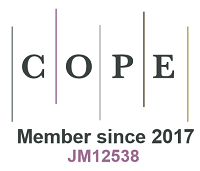Neural-Network Based Prediction of Inelastic Response Spectra
Abstract
The prediction of the nonlinear seismic demand for a given hazard level is still a challenging task for seismic risk assessment. This paper presents a Ground Motion Prediction Model (GMPE) for efficient estimation of the inelastic response spectra of 5% damped Single Degree of Freedom (SDOF) systems, with Elastic-Perfectly-Plastic hysteretic behavior in terms of seismological parameters and structural properties. The model was developed using an Artificial Neural Network (ANN) with Back-Propagation (BP) learning algorithm, by means of 200 records collected from KiK-Net database. The proposed model outputs an inelastic response spectra expressed by a 21 values of displacement amplitudes for an input set composed of three earthquake parameters; moment magnitude, depth and source-to-site distance; one site parameter, the shear wave velocity; and one structural parameter, the strength-reduction factor. The performance of the neural network model shows a good agreement between the predicted and computed values of the inelastic response spectra. As revealed by a sensitivity analysis, the seismological parameters have almost the same influence on the inelastic response spectra, only the depth which shows a reduced impact. The advantage of the proposed model is that it does not require an auxiliary elastic GMPE, which makes it easy to be implemented in Probabilistic Seismic Hazard Analysis (PSHA) methodology to generate probabilistic hazard for the inelastic response.
Keywords
Full Text:
PDFReferences
Tso, W K, and A. S Moghadam. “Pushover Procedure for Seismic Analysis of Buildings.†Progress in Structural Engineering and Materials 1, no. 3 (April 1998): 337–344. doi:10.1002/pse.2260010317.
ATC, Seismic. "Evaluation and retrofit of concrete buildings. vol. 1, ATC-40 report." Redwood City (CA): Applied Technology Council (1996).
Bozorgnia, Yousef, Mahmoud M. Hachem, and Kenneth W. Campbell. “Ground Motion Prediction Equation (‘Attenuation Relationship’) for Inelastic Response Spectra.†Earthquake Spectra 26, no. 1 (February 2010): 1–23. doi:10.1193/1.3281182.
Tothong, P., and C. A. Cornell. “An Empirical Ground-Motion Attenuation Relation for Inelastic Spectral Displacement.†Bulletin of the Seismological Society of America 96, no. 6 (December 1, 2006): 2146–2164. doi:10.1785/0120060018.â€
Rupakhety, R., and R. Sigbjörnsson. “Ground-Motion Prediction Equations (GMPEs) for Inelastic Displacement and Ductility Demands of Constant-Strength SDOF Systems.†Bulletin of Earthquake Engineering 7, no. 3 (April 25, 2009): 661–679. doi:10.1007/s10518-009-9117-6.
Wen, Yi-Kwei. "Method for random vibration of hysteretic systems." Journal of the engineering mechanics division 102, no. 2 (1976): 249-263.
Chopra, A. K. “Dynamics of Structures: Theory and Applications to Earthquake Engineering.†Prentice Hall, New York, (2001).
Ruiz-GarcÃa, Jorge, and Eduardo Miranda. “Inelastic Displacement Ratios for Evaluation of Existing Structures.†Earthquake Engineering & Structural Dynamics 32, no. 8 (April 28, 2003): 1237–1258. doi:10.1002/eqe.271.
Zhao, J. X. “Attenuation Relations of Strong Ground Motion in Japan Using Site Classification Based on Predominant Period.†Bulletin of the Seismological Society of America 96, no. 3 (June 1, 2006): 898–913. doi:10.1785/0120050122.
McVerry, Graeme H., John X. Zhao, Norman A. Abrahamson, and Paul G. Somerville. “New Zealand Acceleration Response Spectrum Attenuation Relations for Crustal and Subduction Zone Earthquakes.†Bulletin of the New Zealand Society for Earthquake Engineering 39, no. 1 (March 31, 2006): 1–58. doi:10.5459/bnzsee.39.1.1-58.
Boore, D.M., W.B. Joyner, and T.E. Fumal. “Estimation of Response Spectra and Peak Accelerations from Western North American Earthquakes; an Interim Report, Part 2.†Open-File Report (1994). doi:10.3133/ofr94127.
Abrahamson, Norman, and Walter Silva. “Summary of the Abrahamson & Silva NGA Ground-Motion Relations.†Earthquake Spectra 24, no. 1 (February 2008): 67–97. doi:10.1193/1.2924360.
Council, Building Seismic Safety. "NEHRP recommended provisions for seismic regulations for new buildings and other structures." FEMA 302 (1997): 303.
Riddell, Rafael, Jaime E. Garcia, and Eugenio Garces. “Inelastic Deformation Response of SDOF Systems Subjected to Earthquakes.†Earthquake Engineering & Structural Dynamics 31, no. 3 (2002): 515–538. doi:10.1002/eqe.142.
Mavroeidis, G. P., G. Dong, and A. S. Papageorgiou. “Near-Fault Ground Motions, and the Response of Elastic and Inelastic Single-Degree-of-freedom(SDOF) Systems.†Earthquake Engineering & Structural Dynamics 33, no. 9 (June 24, 2004): 1023–1049. doi:10.1002/eqe.391.
Li, Hong Nan, Feng Wang, and Zhao Hui Lu. “Estimation of Hysteretic Energy of MDOF Structures Based on Equivalent SDOF Systems.†Key Engineering Materials 340–341 (June 2007): 435–440. doi:10.4028/www.scientific.net/kem.340-341.435.
Prasanth, Tholen, Siddhartha Ghosh, and Kevin R. Collins. “Estimation of Hysteretic Energy Demand Using Concepts of Modal Pushover Analysis.†Earthquake Engineering & Structural Dynamics 37, no. 6 (2008): 975–990. doi:10.1002/eqe.802.
Li, Hong-guang, and Guang Meng. “Nonlinear Dynamics of a SDOF Oscillator with Bouc–Wen Hysteresis.†Chaos, Solitons & Fractals 34, no. 2 (October 2007): 337–343. doi:10.1016/j.chaos.2006.03.081.
Rummelhart, D.E., McClelland, J.L., and Group, P.R. “Parallel distributed processing: Explorations in the microstructure of cognition.†Vol. 1. Foundations. Cambridge, MA: MIT Press (1986).
Aslanargun, Atilla, Mammadagha Mammadov, Berna Yazici, and Senay Yolacan. “Comparison of ARIMA, Neural Networks and Hybrid Models in Time Series: Tourist Arrival Forecasting.†Journal of Statistical Computation and Simulation 77, no. 1 (January 2007): 29–53. doi:10.1080/10629360600564874.
Wang, Lin, Yi Zeng, and Tao Chen. “Back Propagation Neural Network with Adaptive Differential Evolution Algorithm for Time Series Forecasting.†Expert Systems with Applications 42, no. 2 (February 2015): 855–863. doi:10.1016/j.eswa.2014.08.018.
Günaydın, Kemal, and Ayten Günaydın. “Peak Ground Acceleration Prediction by Artificial Neural Networks for Northwestern Turkey.†Mathematical Problems in Engineering 2008 (2008): 1–20. doi:10.1155/2008/919420.
Derras, B., P.-Y. Bard, F. Cotton, and A. Bekkouche. “Adapting the Neural Network Approach to PGA Prediction: An Example Based on the KiK-Net Data.†Bulletin of the Seismological Society of America 102, no. 4 (August 1, 2012): 1446–1461. doi:10.1785/0120110088.
Jamshid, G., and Chu-Chieh, J.L. “New method of generating spectrum compatible accelerograms using neural networks". Earthquake Engineering and Structural Dynamics 27, no.4 (1998): 377-396. doi:10.1002/(sici)1096-9845(199804)27:4<377:: aid-eqe735>3.0.co;2-2
Derbal, Ismail, Nouredine Bourahla, Ahmed Mebarki, and Ramdane Bahar. “Neural Network-Based Prediction of Ground Time History Responses.†European Journal of Environmental and Civil Engineering 24, no. 1 (August 24, 2017): 123–140. doi:10.1080/19648189.2017.1367727.
Hosseinpour, Saeed, and Jafar Najafizadeh. “Seismic Response of Irregular Triangular Alluvial Valleys Under Shear Waves Using Spectral Elements.†Civil Engineering Journal 4, no. 11 (November 30, 2018): 2652. doi:10.28991/cej-03091189.
Karsoliya, Saurabh. "Approximating number of hidden layer neurons in multiple hidden layer BPNN architecture." International Journal of Engineering Trends and Technology 3, no. 6 (2012): 714-717.
Sheela, K. Gnana, and S. N. Deepa. “Review on Methods to Fix Number of Hidden Neurons in Neural Networks.†Mathematical Problems in Engineering 2013 (2013): 1–11. doi:10.1155/2013/425740.
DOI: https://doi.org/10.28991/cej-2020-03091534
Refbacks
- There are currently no refbacks.





